Understanding “What Is A Sales Funnel In Digital Marketing” is paramount in digital marketing. A sales funnel guides potential customers from awareness to purchase. It’s the backbone of effective online marketing.
Moreover, it aids businesses in engaging, nurturing, and ultimately converting leads to loyal customers. By optimizing your sales funnel, you can streamline and enhance your digital marketing efforts for maximum effectiveness.
Today, in this guide, we’ll delve into the intricacies of the digital marketing sales funnel, exploring its stages and how it serves as a cornerstone for online success.
Let’s get started.
Table of Contents
What Is A Sales Funnel In Digital Marketing?
When it comes to digital marketing, a sales funnel is a plan that shows how a customer will go from first hearing about a product or service to actually buying it. Awareness, consideration, decision, and post-purchase are some of the steps that make up the process. It guides potential customers through a structured path to improve lead conversion and customer retention.
The Importance Of Sales Funnels In Digital Marketing
Sales funnels play a crucial role in digital marketing for a variety of reasons:
- Lead Generation: Sales funnels are a structured approach to generating and managing leads effectively. They help you move potential customers through the buyer’s journey.
- Improved Conversion Rates: By understanding the different stages of the sales funnel, you can tailor your marketing messages and content. That meets your target audience’s specific needs and interests. This personalized approach leads to higher conversion rates.
- Targeted Marketing: Sales funnels allow you to segment your audience based on their stage in the funnel. This enables you to deliver the right message to people at the right time. Also, increase the effectiveness of your marketing campaigns.
- Data-driven Decision Making: By tracking the progress of individuals through the sales funnel, you can gain valuable insights into customer behavior and preferences. This data can inform your marketing strategies and help you make data-driven decisions for better results.
By optimizing your sales funnel, you can enhance your marketing efforts and drive business growth.
Stages Of A Sales Funnel In Digital Marketing
A sales funnel often comprises numerous stages that indicate a potential customer’s journey. The following are the stages:
Awareness Stage: Attracting Potential Customers
In the awareness stage of a sales funnel, the goal is to capture the attention of potential customers. It makes them aware of your products or services. This can be done through various marketing techniques, such as social media advertising, content marketing, and search engine optimization. The key is to create compelling and targeted content that grabs the interest of your target audience and brings them into your funnel.
Consideration Stage: Educating And Building Interest
Once potential customers know your brand, the next step is to educate them about your offerings and build their interest. This stage involves providing informative and valuable content, such as blog posts, videos, and webinars, that address their pain points and show them how your products or services can solve their problems. The goal is to establish yourself as a trusted authority in your industry and building a relationship with your leads.
Decision Stage: Convincing and Converting Leads
In the decision stage, your leads are ready to purchase. This is the time to provide them with compelling offers, such as discounts, free trials, or limited-time promotions, to convince them to choose your brand over competitors. There should be clear and convincing calls to action to get them to do what you want, like buy something or ask for a meeting.
Action Stage: Closing The Sale
The bottom sales funnel stage is the action stage, where the lead becomes a paying customer. It’s essential to provide a seamless and positive customer experience during this stage to ensure customer satisfaction and encourage purchases.
Post-Purchase Stage: The Last Stage And Retaining Customers
The relationship with the customer doesn’t end with a purchase. It’s crucial to continue engaging with and nurturing customers, ensuring their satisfaction, and encouraging repeat business or referrals. This can involve personalized follow-up emails, excellent customer service, and ongoing engagement through loyalty programs or exclusive offers.
Note: At the sales funnel stage, you need a different marketing plan and piece of content to help potential customers through the process and eventually turn them into loyal customers.
How To Create A Sales Funnel In Digital Marketing?
Creating an effective sales funnel in digital marketing involves steps and strategic planning. Here’s a step-by-step guide on how to create a sales funnel:
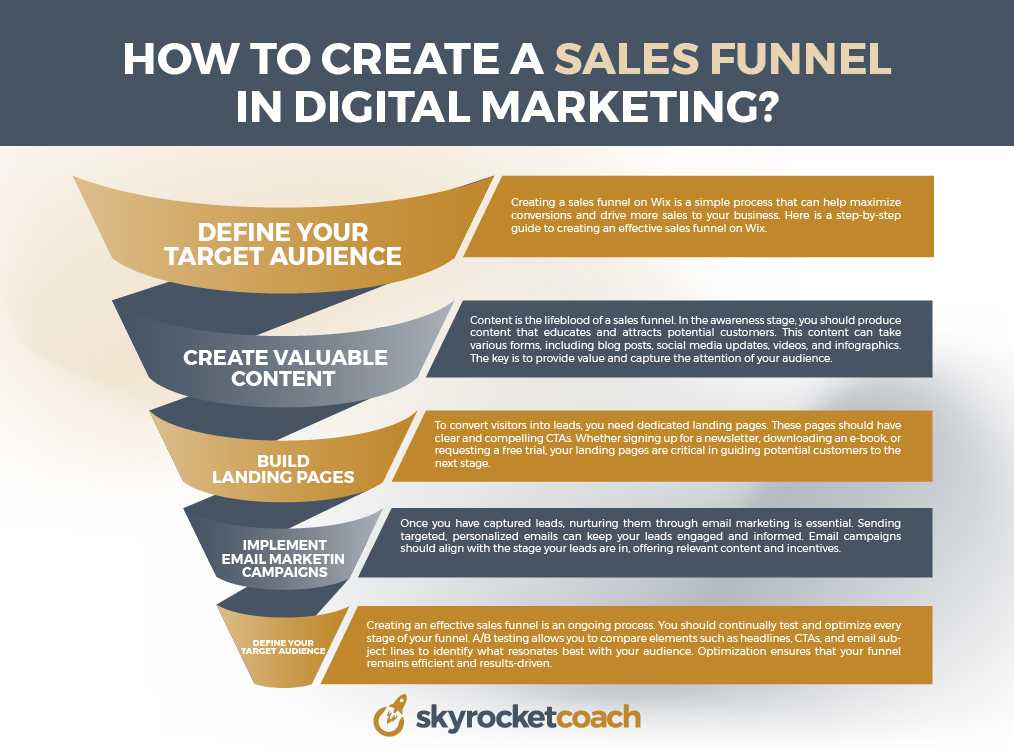
Step 1: Define Your Target Audience
Before you can create a sales funnel, you need to know who your ideal customers are. Start by defining your target audience’s demographics, interests, pain points, and behaviors. The more specific your audience persona, the more tailored your funnel can be.
Step 2: Create Valuable Content
Content is the lifeblood of a sales funnel. In the awareness stage, you should produce content that educates and attracts potential customers. This content can take various forms, including blog posts, social media updates, videos, and infographics. The key is to provide value and capture the attention of your audience.
Step 3: Build Landing Pages
To convert visitors into leads, you need dedicated landing pages. These pages should have clear and compelling CTAs. Whether signing up for a newsletter, downloading an e-book, or requesting a free trial, your landing pages are critical in guiding potential customers to the next stage.
Step 4: Implement Email Marketing Campaigns
Once you have captured leads, nurturing them through email marketing is essential. Sending targeted, personalized emails can keep your leads engaged and informed. Email campaigns should align with the stage your leads are in, offering relevant content and incentives.
Step 5: A/B Testing and Optimization
Creating an effective sales funnel is an ongoing process. You should continually test and optimize every stage of your funnel. A/B testing allows you to compare elements such as headlines, CTAs, and email subject lines to identify what resonates best with your audience. Optimization ensures that your funnel remains efficient and results-driven.
Note: Regularly analyze and optimize your funnel to ensure it continues to drive conversions and generate revenue.
What Is A Sales Funnel In Digital Marketing With Examples
Let’s look at some real-world digital marketing funnel examples to demonstrate how sales funnels may be used:
Example 1: Amazon
Amazon, the e-commerce giant, has perfected the art of sales funnels. When visitors land on their website, they are immediately presented with personalized product recommendations based on their past searches and purchases. This is the awareness stage, drawing the user’s attention.
As users browse products, Amazon uses data-driven algorithms to show complementary items and create a sense of urgency with limited-time offers. These tactics align with the consideration and decision stages, gently guiding the user towards purchasing.
After a purchase, Amazon continues to engage customers through email, offering product suggestions, and promoting its loyalty program, Amazon Prime. This post-purchase stage ensures that customers stay engaged, leading to repeat purchases.
Example 2: HubSpot
HubSpot, a marketing and sales software company, is renowned for its inbound marketing strategies. They provide valuable content through blog posts, e-books, and webinars, capturing leads at the awareness stage.
HubSpot’s landing pages offer free tools and resources for contact information. Once leads are in the system, HubSpot uses email marketing to nurture these leads with more educational content, address their pain points, and build trust (consideration stage).
Finally, they present the leads with tailored offers and a clear path to purchase their premium marketing automation software (decision stage). HubSpot’s post-purchase engagement includes onboarding and training, ensuring customers maximize the software’s value.
Note: These examples show that sales funnels are abstract ideas and methods businesses use to attract, convert, and keep customers.
Tools And Strategies For Optimizing Sales Funnels
Lead Generation And Capture Techniques
A sales funnel is a process that guides potential customers through the various stages of purchasing your products or services. Understanding how a sales funnel works and implementing practical tools and strategies can help optimize your digital marketing efforts.
To begin, you need to generate leads. This can be done through various techniques, such as creating engaging content, using lead generation forms or landing pages, and running targeted advertising campaigns. These methods help capture the contact information of potential customers, allowing you to continue nurturing the relationship.
Nurturing Leads With Email Marketing
Once you have captured leads, it’s important to engage and nurture them through email marketing. This involves sending targeted and personalized emails to provide valuable content, offers, and updates. Email automation tools such as Mailchimp or HubSpot can streamline this process and allow you to segment your leads based on their interests and behavior.
By consistently providing valuable information and building a relationship with your leads, you increase the chances of converting them into paying customers. It’s important to track and analyze the performance of your email campaigns to optimize your messaging and conversion rates.
Note: Applying these tools and strategies can attract more leads, nurture them through buying, and ultimately increase your sales and revenue.
Analyzing And Improving Sales Funnels
Tracking And Analyzing The Sales Funnel Performance
To effectively optimize your digital marketing sales funnel, tracking and analyzing its performance is crucial. This allows you to identify areas where potential customers drop off and develop strategies to improve conversion rates. Here are some key steps to consider:
- Use analytics tools: Utilize tools like Google Analytics to track crucial metrics such as website traffic, click-through rates, and conversion rates at each funnel stage.
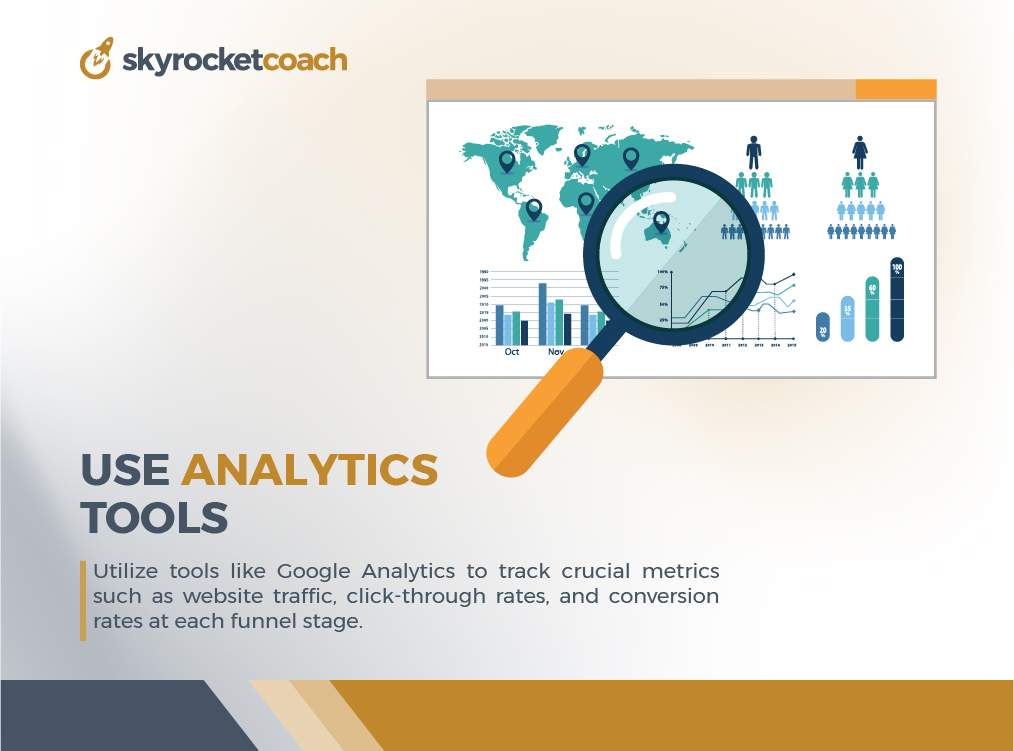
- Monitor customer behavior: Analyze how visitors navigate your website, where they drop off, and which pages generate the most conversions. This data provides valuable insights into user preferences and pain points.
- Segmentation: Categorize your audience into segments based on demographics, behavior, or interests. This allows you to tailor your marketing efforts and messaging to specific groups, increasing the chances of conversion.
Sales Funnel Success Key Insights And KPIs
Now that we’ve explored the creation and application of sales funnels in digital marketing, it’s essential to discuss how to measure the success of your efforts. Key performance indicators (KPIs) and metrics can help you determine how well your sales process is working.
Key Insights and KPIs:
- Conversion Rate: This metric measures the percentage of visitors who take the desired action, such as signing up for a newsletter or purchasing.
- Click-Through Rate (CTR): CTR indicates the percentage of people who click on a CTA or link within an email or webpage.
- Customer Acquisition Cost (CAC): CAC measures acquiring a new customer. Ensuring the cost doesn’t exceed the customer’s lifetime value is essential.
- Customer Lifetime Value (CLV): CLV represents the total revenue a customer is expected to generate over their lifetime as your customer.
- Churn Rate: This metric indicates the rate customers stop doing business with you. A low churn rate is indicative of good customer retention.
- Email Open and Click Rates: These rates measure the engagement with your email campaigns. A higher open and click rate signifies effective email marketing.
- Sales Funnel Conversion Rates: Analyzing the conversion rates at each funnel stage provides insights into where potential customers drop off or proceed.
By tracking these metrics and KPIs, you can evaluate the performance of your sales funnel and make data-driven decisions to improve it.
Identifying And Addressing Bottlenecks In The Funnel
Identifying and addressing bottlenecks in the sales funnel is essential for improving overall conversion rates. Here are some strategies to consider:
- Analyze drop-off points: Identify the stages where customers will most likely abandon the funnel. isolate the reasons for drop-offs, such as unclear messaging, complicated checkout processes, or lack of trust-building elements.
- Optimize landing pages: Ensure your pages are clear, persuasive, and aligned with customers’ expectations. Use compelling headlines, persuasive copy, and prominent calls to action to encourage conversions.
- Streamline the checkout process: Simplify and streamline the process to minimize friction and reduce the likelihood of cart abandonment. remove unnecessary steps, optimize form fields, and offer guest checkout options.
Note: Monitoring and addressing sales funnel issues can boost conversion rates, client satisfaction, and digital marketing success.
Benefits Of Implementing A Sales Funnel In Digital Marketing
Using a sales funnel as part of your digital marketing plan has several benefits:
- Streamlined Customer Journey: A sales funnel provides a clear pathway for potential customers. Also, ensure they receive the right message at the right time, increasing the likelihood of conversion.
- Improved Customer Relationships: By guiding customers through a personalized journey, you can develop stronger relationships and build trust, leading to higher customer loyalty and repeat business.
- Enhanced Conversion Rates: A sales funnel can significantly increase conversion rates through targeted messaging and strategic nurturing, maximizing the return on your marketing investment.
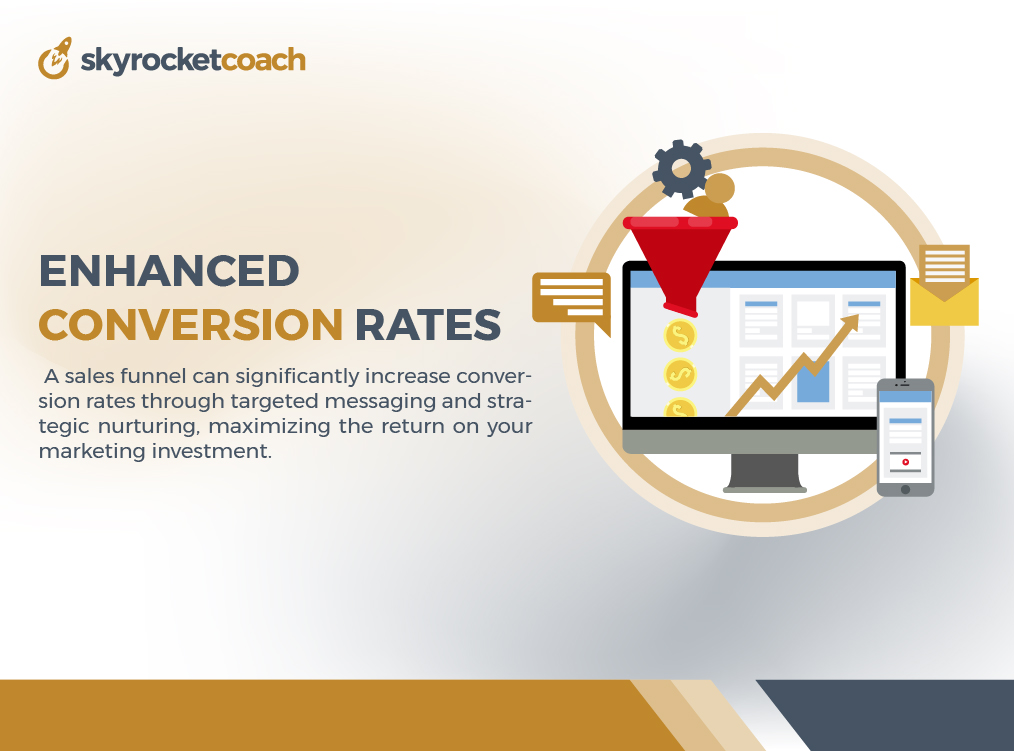
Future Trends in Sales Funnel Marketing
As digital marketing develops, sales funnels adapt to new trends and technologies. Here are some future trends to keep an eye on:
- Emerging Technologies: Artificial intelligence and machine learning will be more prominent in personalizing and automating the sales funnel process.
- Changing Consumer Behavior: Consumer behavior is evolving, focusing on sustainability, ethical practices, and social responsibility. Future sales funnels may need to align with these changing values.
- Multi-Channel Funnels: With consumers using multiple channels and devices, multi-channel funnels that provide a seamless experience will become increasingly important.
Final Thoughts
Understanding “What Is A Sales Funnel In Digital Marketing” is paramount for any business looking to thrive in the digital landscape. Sales funnels aren’t just theoretical concepts but also practical tools. It can supercharge your online marketing efforts.
With the correct approach and insights, sales funnels may improve your firm’s lead conversion, customer retention, and growth.
If you seek expert guidance and support in optimizing your digital marketing strategies, look no further than Skyrocket Coach. Our services train businesses like yours how to develop and maintain sales funnels to boost their online visibility.
It’s time to take action and witness the transformative impact of sales funnels in your digital marketing journey.
FAQs About What Is A Sales Funnel In Digital Marketing
What Is The Purpose Of A Sales Funnel In Digital Marketing?
A sales funnel guides potential customers through a structured journey, from awareness to conversion. Its purpose is to increase lead conversion rates and nurture customer relationships effectively.
What Is The B2C Sales Funnel In Digital Marketing?
The B2C sales funnel in digital marketing caters to consumer-oriented businesses. It involves stages like awareness, consideration, decision, and post-purchase to engage and convert individual customers.
What Is A SaaS Sales Funnel In Digital Marketing?
A SaaS (Software as a Service) sales funnel is specific to software providers. It focuses on lead generation, free trials, and subscription conversions, tailoring the journey to the needs of potential software users.
Why Is A Sales Funnel Better Than A Website?
A sales funnel offers a more guided and optimized path to lead conversion, whereas a website is a static online presence. Funnel stages nurture and engage leads, making it more effective in turning visitors into customers.

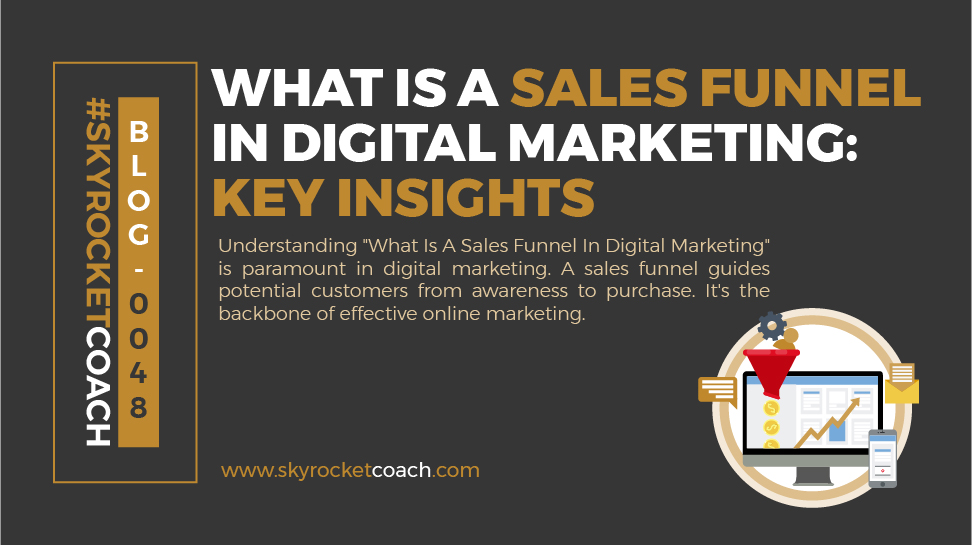
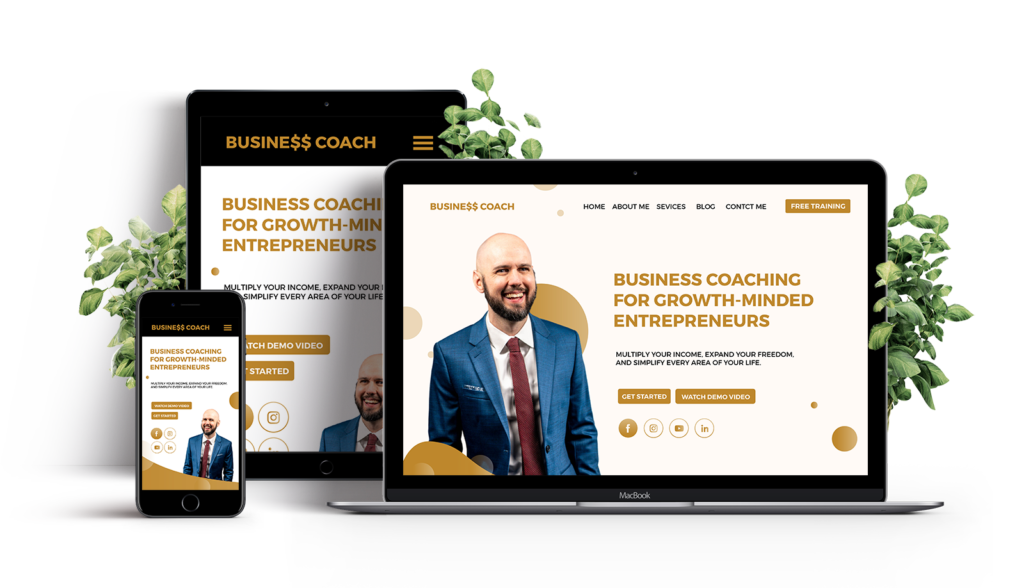

Recent Comments